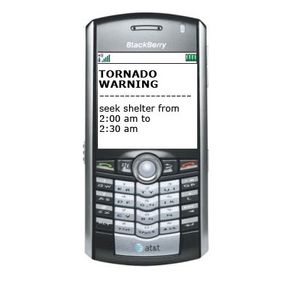The simplest example of a targeted emergency notification system is a phone tree. Phone trees are an effective way to quickly contact a small to medium-size group of people (less than 100). Phone trees are considered a targeted notification because only the specific people who are affected by the emergency are called. Here's how phone trees work:
- The organizer makes a list of all the members of the phone tree, including all pertinent contact information.
- Employees use the Web portal or software to add individual contact information to the database, including phone and fax numbers and e-mail addresses.
- The organizer assigns each key member a small group of people to call (not more than 10).
- In an emergency, the organizer calls the key members with a scripted message.
- The key members relay the message to everyone on their call list until receipt of the message is confirmed. If someone cannot be contacted after a predetermined amount of time, the key member informs the organizer.
Phone trees have limitations:
- If one or more key members can't be reached, that shifts the responsibility back to the organizer or other key members, who may not be able to make all the calls in time.
- The larger the group, the greater the likelihood that one or more of the key members will not be available.
- Phone trees are limited because they rely exclusively on one means of communication. The ability to send messages over multiple platforms is a chief advantage of automated electronic notification systems, which we'll talk about next.
Many companies offer mass notification and emergency notification services. These services are basically powerful, automated phone trees. They can simultaneously send an emergency alert to thousands of people over all available communications platforms: e-mail, phone, cell phone, SMS, pager, PDA and fax.
Most mass notification services are subscription-based, which means that all the software and hardware necessary to run the system is housed off-site. Clients access the system through a desktop Web portal or a simple desktop API (application programming interface). Here's how a typical subscription mass notification system works:
- Employees of the company or organization access the electronic notification system through a Web portal or simple software interface on their desktop.
- Employees use the Web portal or software to add individual contact information to the database, including phone and fax numbers, e-mail address and SMS.
- The Web portal or software allows users to organize contacts into an unlimited number of groups and subgroups. Most allow you to upload contacts and groups from existing e-mail programs like Microsoft Outlook. (Some electronic notification systems suggest that companies delegate authority to certain users only for contacting the largest groups.)
- When it's time to initiate a notification, users log onto the Web portal or access the system by phone.
- Users then choose over which platforms they'd like to send their message. Most electronic notification services include text-to-speech capability so a written message can also be sent as audio to phones.
- Once the message is typed or recorded and sent, it arrives at the off-site headquarters of the electronic notifications service, where servers instantly send the message off to five or 500,000 recipients.
There are many potential applications for automated emergency notifications:
- Severe weather
- Wildfire/earthquake/tsunami/flood
- Terrorist attack
- Industrial accident
- Child abduction
- Dangerous persons in the area
Many municipalities and townships contract with mass notification services to keep citizens informed of emergencies. Washington D.C., for example, has a system in which citizens can sign up to receive emergency alerts by e-mail, SMS and cell phone.
These systems can also be linked with geographical data to create highly targeted and effective messages. Mass notification company 3n has a product called the InstaCom GIS system that allows municipal emergency workers and law enforcement officials to target messages using a GPS map interface. Officials can send alerts to residents living in a certain zip code or contact homes within a certain radius of an emergency.
These geographically based systems are especially effective for warning citizens in the event of a localized gas leak, chemical spill, child abduction, or even a prison escape.
Here are some of the features and advantages of automated mass notification systems:
- Saves precious time in an emergency by contacting all constituents simultaneously
- Frees up emergency workers and employees to concentrate on other tasks
- Improves chances that the message is received by contacting recipients over all available communications platforms
- Messages can be sent by Web or by phone, ensuring that critical alerts can still be sent even when there is no Internet connection
- Ability to track and confirm receipt of message in real time
- Some notification systems stop contacting members after a certain number, particularly helpful when a volunteers are needed quickly
- Ability to record messages and leave them on a virtual bulletin board accessible by employees or constituents through a special 800 number and PIN
Read on to find out more about emergency notifications and the technology that powers them.


